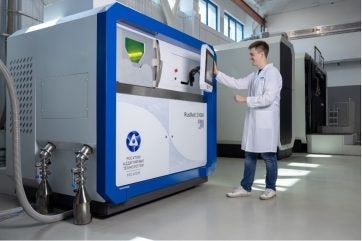
Rosatom’s 3D printing centre (Photo credit: Rosatom)
Specialists from Rosatom’s Additive Technologies business area have for the first time produced a component using 3D printing for use at a nuclear facility. A pump impeller has been produced using a 3D printer for the uranium conversion facility at the Siberian Chemical Combine in Seversk, Tomsk Region.
The product was grown using selective laser melting technology on a RusMelt-300 3D printer, which is produced by NPO Centrotech, a resident of the Novouralsk Priority Development Area (TOR – Territoriya Operazhayuchevo Razvitiya). The printer runs on Russian software and has parameters and characteristics that meet international standards in the field of additive manufacturing.
According to the requirements of design engineers, the pump impeller must have a strictly defined shape with bending that cannot be achieved using traditional methods. The accuracy of the finished component’s correspondence to the original three-dimensional model affects the performance and energy efficiency of the pumping unit and the entire equipment complex. The use of three-dimensional printing made it possible to achieve maximum compliance of the finished product with design documentation, and also increased strength and reduced weight.
“The first case of using a product made using 3D printing at a nuclear facility will be another confirmation of the high quality and reliability of additive manufacturing of parts and components,” said Ilya Kavelashvili, Director of Rosatom’s Additive Technologies business area. “Rosatom is carrying out comprehensive work to introduce additive technologies in the nuclear industry. Our working group included more than 60 chief designers, end consumers, metrologists, and representatives of certification bodies. A list of 120 parts that are advisable to print on 3D printers has been prepared. We selected 10 samples of different safety classes from them, which will be references. These include the anti-debris filter of the fuel assembly, the baffle of the internal device of the VVER-TOI nuclear reactor and others. During the tests, we will prove that they are reliable for industrial use, and this will form the basis of a regulatory framework for the use of additive technologies in the nuclear industry.”
The centrifugal pump, which has a 3D printed impeller, is used to circulate water through an internal heat exchanger. Such devices ensure reliable operation of equipment at the hydrogen fluoride production site and directly in providing anhydrous hydrogen fluoride to the fleet of electrolysers in the production of uranium hexafluoride for nuclear fuel.
Rosatom’s statement on its first 3D component came in the run up to the 6th Leader-Forum on Additive Technologies later in November, which will be held at Rosatom’s Pavilion at the All Russian Exhibition Centre (VDNKh – Vistravka Dostizhenii Narodnovo Khozyaistva) in Moscow. The Leader Forum is a key event in the field of 3D printing in Russia. The programme includes discussions between business and government on the topic Additive technologies for achieving technological leadership. There will also be an Additive gallery of applied and industrial 3D printed exhibits made of metal, sand, plastic etc. The event will be the largest in its six-year history with over 2,000 participants, 120 companies, 50 speakers, including officials from the Russian Ministry of Industry & Trade, Rosatom, Roscosmos and Rostek.
